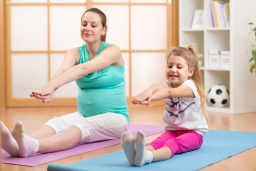Mom and Me: Active Lifestyles Begin at Home!
Wednesday, May 17, 2017 - 09:00

A physically active lifestyle begins to develop early in childhood. Almost 31% of Canadian children and youth 5-19 years of age are overweight or obese and if the current trends continue, by 2040, 70% of 40-year-olds will be overweight or obese. The importance of physical activity at an early age does, however, give us an idea of possible strategies to target the widespread physical activity deficit.
In preschool-aged children, activity levels of mothers are positively associated with those of their children. This mother-child relationship exists throughout the day, for both low and moderate-to-vigorous intensities, and is mutually beneficial: an active mother may encourage her child to be physically active, while an active child may require his or her mother to be more active. The end result is an increase in activity for either, and ultimately, desirable health outcomes for both.
As children age, parents continue to have an influence on physical activity. Mother modelling, specifically, is based on the child’s perception of the mother’s exercise and participation in sport. It can influence the child’s perceived competence compared to other kids of the same age, as well as the child’s attraction to physical activity. These factors, in turn, affect children’s physical activity participation.
It is not just the mother that influences children’s physical activity: both parents play a role. Children with parents that engage in more sport participation generally have higher physical activity levels than those with less active parents. Whether it is through observing participation of their parents or through co-participation, children are impacted by maternal and paternal modelling through the positive values of physical activity they instill. Active parents are also more likely to support their children’s own physical activity.
Granted, because of different study designs and the numerous factors at play, it is hard to pinpoint an overarching, general conclusion about the exact relationship between parental and child physical activity. This is especially true when children transition through adolescence and the influence of peers and coaches grows. Parental support, however, is consistently associated with greater levels of physical activity. Co-participation, encouragement, and facilitating participation by providing transportation and equipment all influence children’s physical activity. Rather than these individual behaviours, though, it is the supportive actions and attitudes as a whole that have the largest effect.
With variable outcomes arising from interventions geared towards overweight and obese children, one of the best ways to combat the obesity epidemic may be to take a preventative approach. Children between 5-17 years old should participate in at least 60 minutes of moderate-to-vigorous physical activity every day. Given that early physical activity impacts and promotes the development of a physically active lifestyle, and that the stability of physical activity participation remains moderate to high into youth and adulthood, we should capitalize on this period of growth and learning to develop healthy habits for life. Engaging in physical activity as a family results in a variety of gains for everyone involved, but even if parents are limited in their participation, support for their children’s continued physical activity is instrumental in setting them up for an active life.
Resources for active mothers with young children:
The Canadian Society for Exercise Physiology released an evidence-based 24-hour Movement Guideline for Children and Youth in 2016, and have guidelines for all other age groups, too.
Resources for physical activity during pregnancy:
Mothers can also begin, or keep, engaging in physical activity during pregnancy. These SIRCuit articles and SIRC blogs outline the many benefits of exercise during pregnancy, as well as the guidelines for safe participation:
- SIRC facts on Pregnancy
- Staying Fit while Pregnant: Tips for a Safe Workout
- Exercise during pregnancy for elite athletes: current evidence & training recommendations
- Physical Activity for the New Mom
Sources:
Hesketh KR, Goodfellow L, Ekelund U, McMinn AM, Godfrey KM, Inskip HM, Cooper C, Harvey NC, van Sluijs EMF. Activity levels in mothers and their preschool children. Pediatrics. 2014; 133(4): e973-980.
Määtä S, Ray C, Roos E. Associations of parental influence and 10–11-year-old children’s physical activity: Are they mediated by children’s perceived competence and attraction to physical activity? Scandinavian Journal of Public Health. 2014; 42(1): 45-51.
Roberts KC, Shields M, de Groh M, Aziz A, Gilbert J. (2015) Overweight and obesity in children and adolescents: Results from the 2009 to 2011 Canadian Health Measures Survey. Statistics Canada.
Peirson L, Fitzpatrick-Lewis D, Morrison K, Ciliska D, Kenny M, Ali MU, Raina P. Prevention of overweight and obesity in children and youth: a systematic review and meta-analysis. Canadian Medical Association Journal Open. 2015; 3(1): E23-E33.
Schoeppe S, Robl M, Liersch S, Krauth C, Walter U. Mothers and fathers both matter: The positive influence of parental physical activity modeling on children’s leisure-time physical activity. Pediatric Exercise Science. 2016; 28(3): 466-472
Statistics. Childhood Obesity Foundation.
Telama R, Yang X, Leskinen E, Kankaanpää A, Hirvensalo M, Tammelin T, Viikari JSA, Raitakari O. Tracking of physical activity from early childhood through youth into adulthood. Medicine & Science in Sports & Exercise. 2014; 46(5): 955-962.
Yao CA, Rhodes RE. Parental correlates in child and adolescent physical activity: A meta-analysis. International Journal of Behavioural Nutrition and Physical Activity. 2015; 12(10): 1-38.
About the Author: Lily is a fourth-year student in the kinesiology program at Western University. With a background in synchronized swimming, she continues to be actively involved in the sport as a coach and varsity athlete.